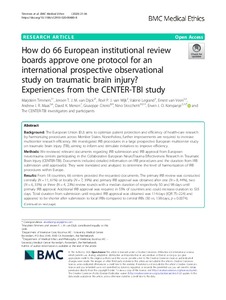How do 66 European institutional review boards approve one protocol for an international prospective observational study on traumatic brain injury? Experiences from the CENTER-TBI study
Timmers Marjolein; van Dijck Jeroen TJM; van Wijk Roel PJ; Legrand Valerie; van Veen Ernest; Maas Andrew IR; Menon David K; Citerio Giuseppe; Stocchetti Nino; Kompanje Erwin JO; CENTER-TBI investigators and participants
https://urn.fi/URN:NBN:fi-fe2021042713511
Tiivistelmä
Background
The European Union (EU) aims to optimize patient protection and efficiency of health-care research by harmonizing procedures across Member States. Nonetheless, further improvements are required to increase multicenter research efficiency. We investigated IRB procedures in a large prospective European multicenter study on traumatic brain injury (TBI), aiming to inform and stimulate initiatives to improve efficiency.
Methods
We reviewed relevant documents regarding IRB submission and IRB approval from European neurotrauma centers participating in the Collaborative European NeuroTrauma Effectiveness Research in Traumatic Brain Injury (CENTER-TBI). Documents included detailed information on IRB procedures and the duration from IRB submission until approval(s). They were translated and analyzed to determine the level of harmonization of IRB procedures within Europe.
Results
From 18 countries, 66 centers provided the requested documents. The primary IRB review was conducted centrally (N = 11, 61%) or locally (N = 7, 39%) and primary IRB approval was obtained after one (N = 8, 44%), two (N = 6, 33%) or three (N = 4, 23%) review rounds with a median duration of respectively 50 and 98 days until primary IRB approval. Additional IRB approval was required in 55% of countries and could increase duration to 535 days. Total duration from submission until required IRB approval was obtained was 114 days (IQR 75–224) and appeared to be shorter after submission to local IRBs compared to central IRBs (50 vs. 138 days, p = 0.0074).
Conclusion
We found variation in IRB procedures between and within European countries. There were differences in submission and approval requirements, number of review rounds and total duration. Research collaborations could benefit from the implementation of more uniform legislation and regulation while acknowledging local cultural habits and moral values between countries.
Kokoelmat
- Rinnakkaistallenteet [27094]
